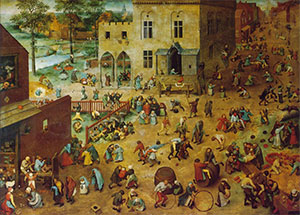LET’S PLAY! GAMES AND TOYS FROM RENAISSANCE TO BAROQUE
Francesco Carelli, University Milan
The National Gallery of the Marche in Urbino opened its doors to young and old for a trip back in time with the exhibition “ play! Games and toys from the Renaissance to the Baroque “ .
Organized by the National Gallery in Urbino with the prestigious collaboration of the Kunsthistorisches Museum, the exhibition tells the two important historical periods of the Renaissance and Baroque through an unusual and original location of games, toys and hobbies that spread from the fifteenth to six hundred throughout Europe.
The exhibition, created by Arthemisia Group, includes playing cards, chess, books, toys, paintings and engravings from prestigious Austrian, German and Italian collections. Along with representations of game scenes like the picture with the chess game of Palazzo Madama in Turin fields, some very rare works transport the visitor into a world of ” fun ” that right from start is surprising for its preciousness: have such a great impact the chessboard with figures of sixteenth chess in gold and in silver or inlaid ivory box containing miniature toys.
In 1500 Montaigne (1533 – 92) argued that ” the children of the games are not games and you have to judge their actions more seriously ” .
Considered as the first form of expression of creativity, the game has always been subject of interest by the most illustrious thinkers who have argued the educational role in different eras.
Right from antiquities children had available numerous playing opportunities related to the life to ‘ open and all ‘ use of readily available materials in nature. During the Renaissance, they believed that the game is not only fun but a serious commitment, with clear targets to be achieved and an educational tool that allows the child to grow up. In the houses of the nobility to the young were reserved certain games useful for building its future: the girls dolls of cloth and small household utensils, the boys wooden, ceramic and lead figurines reproducing horses and characters . Tactical games such as chess, checkers and thread, helped to develop then applicable strategies in the military field. In the spirit of the Renaissance, in so-called ” rooms of wonders ” of palaces and castles there were increasingly hosted games made with great skill and ingenuity, including clusters of hand-painted cards or curiosity.
The exhibition in Urbino was inspired by the discovery, during restoration work carried out in the attic of the throne at the Palazzo Ducale Hall, of a ” game ball ” of early seventeenth century, much like the one you see in the portrait of Federico Ubaldo della Rovere of Alessandro Vitali (Lucca, Museo Nazionale di Palazzo Mansi), which welcomes visitors beginning to visit the exhibition.
The core of the exhibits is presented in the city of Urbino with an exhibition starring games and pastimes practiced from the fifteenth to the seventeenth century and tells how to play activities were not at all ” a child’s game ” but practiced by an adult audience and belonging to a higher social class.
Sporting Games played during the renaissance are typically games where the physical capacity of an individual or a specialized skill of a person is required. It almost seems like if an object could be pulled, lifted, pushed, moved, or thrown, there was some sort of game attached to it. For instance there is a game called Skittles, which is the ancestor of 10 pin bowling. There were also games like archery and wrestling. A few other favorite sporting games of the renaissance are jousting and mock combat. There was also a game called Football back then, though it is not quick the same as the modern sport. They played with 25 people on each side and the ball was made up from leather.
The creativity of a child’s mind to create games can never be matched as we can see in the attached picture. In that picture there are probably 25 to 50 different games that are being played. Some examples of renaissance games you can play with your children in the picture are marbles, tag, hide and go seek, walking on stilts, climbing over things, and swimming. The one I am wondering about is the kid hanging out the window with a basket in his hand. Could that be the equivalent of dropping a water balloon on someone?
“Children’s Games” By Pieter Brueghel the Elder. Oil on Panel 1560

There are games played on some sort of board or matt. The board or matt can be made from cloth, wood, or stone. Some examples are chess, mancala, Fox & Geese, and Backgammon. During the renaissance time chess and checkers were very popular. It has been theorized that the version of chess we play in modern times has the same rules and version of chess that was played at that time.
Dice games are also known as games of chance and have pretty well be banned throughout history in one form or another. In dice a player throw one of more dice and based on what symbols come up the player then has to make some sort of choice.
Card games are played with a set of cards. This can be from a traditional 52 card deck or from a Tarot deck. Some examples are All Four’s, One and Thirty, which is a precursor to blackjack, and Noddy, which is the ancestor to cribbage.



